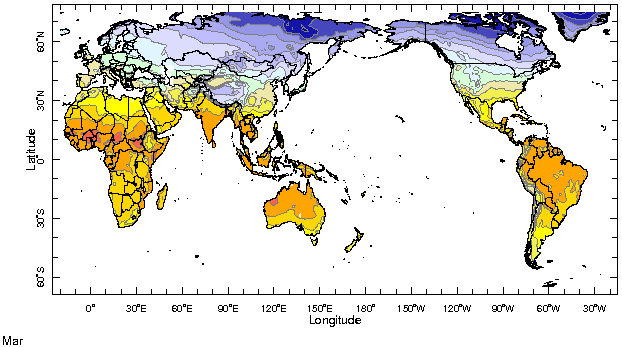|
IRI Climate Digest
April 2004
March Global Climate Summary
Climatological Background
In March, the sun crosses the equator (the Equinox) and begins its migration into the Northern Hemisphere. It is the transition from winter to spring in the Northern Hemisphere, when temperatures begin to increase and storm tracks move northward. In the Southern Hemisphere summer is ending and the monsoon rains are retreating northward.
Monthly Mean Temperature (1961-1990), data from the Climate Research
Unit, University of East Anglia


Monthly Mean Precipitation (1961-1990), data from the Climate Research
Unit, University of East Anglia


Temperatures
Highlights
While temperatures returned to near average in north-central Asia in March, they remained well above average from far eastern Europe southward to the Indian Subcontinent. Temperatures were also well above average in the western United States. In the Southern Hemisphere, above-average temperatures were observed across much of South America and eastern Africa. Temperatures lowered to below-average values in western Australia.
Temperature Difference from the 1961-1990 mean, with data
from NCEP Climate Prediction Center, CAMS.


Precipitation
Highlights
Heavy, late season rains in parts of southern Africa brought flooding to some areas, particularly along the Zambezi River. Drier conditions returned to northeastern Brazil in March while below-average rainfall continued across extreme southern Brazil, Uruguay and northeastern Argentina. Drier-than-average conditions continued across much of central-southwest Asia during the month as the end of the winter precipitation season approached.
Precipitation Difference from 1979-1995 mean, with data
from NCEP Climate Prediction Center, CAMS-OPI.


Oceanic Conditions
Tropical Pacific: Sea surface temperatures have not changed significantly over the past month in the equatorial Pacific. Temperatures remain above normal in the western Pacific, with near-normal conditions east of the dateline, and slightly below normal just off the coast of Peru. See the latest IRI ENSO Update for a detailed summary and outlook.
Tropical Atlantic: The eastern tropical Atlantic cooled slightly during March. Above-average temperatures continued along the west coast of North Africa.
Indian Ocean: Surface temperatures cooled somewhat over the past month, but have remained warmer-than-normal across a large area of the central Indian Ocean. Below-average temperatures continued along the west coast of Australia.
Mid-latitudes: Temperatures in the North Atlantic Ocean remained above average in the eastern portion of the basin, with below-average temperatures persisting along the eastern coast of North America. Generally cooler-than-average temperatures were observed across much of the South Atlantic, although surface waters were warmer than average off the coast of Argentina. Temperatures were near-normal across much of the North Pacific, with slightly above-average conditions in the subtropics. The dominant feature of the extratropical South Pacific is the persistent above-average temperatures in the central part of the basin.
Monthly Sea Surface Temperature Difference from the 1971-2000 mean,
with data from the Environmental Modeling Center, NCEP/NOAA.


Contents |
Special |
Impacts |
Climate |
Forecast
| 
